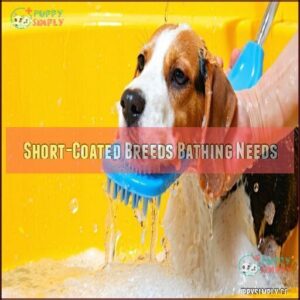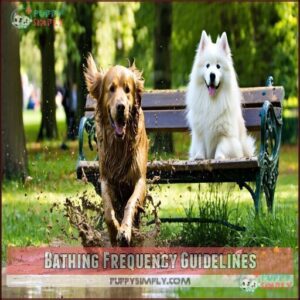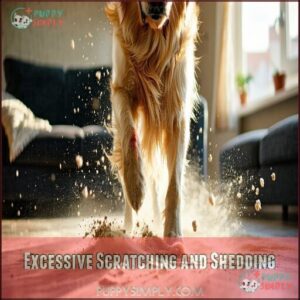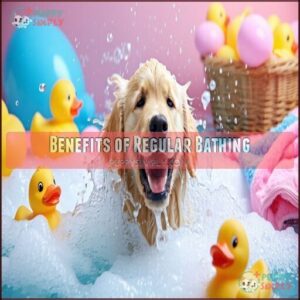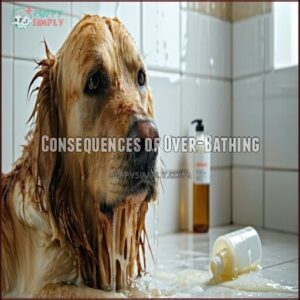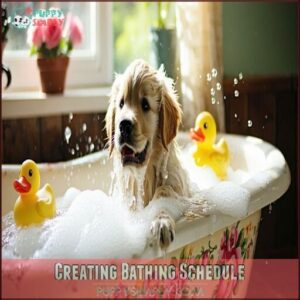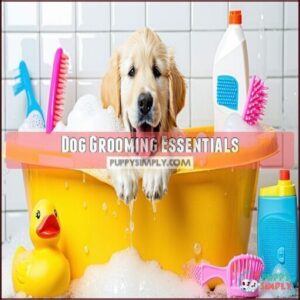This site is supported by our readers. We may earn a commission, at no cost to you, if you purchase through links.

Most dogs do fine with a bath every 4-6 weeks, but active pups or those with skin conditions might need more frequent washes.
Hairless breeds often require weekly baths, while long-coated breeds may need extra care to prevent matting.
Over-washing can strip natural oils, leading to dry skin, so stick to gentle shampoos. If your dog smells funky or looks dirty, it’s bath time!
When in doubt, ask your vet—they’re the real pros. Curious about tailoring a routine for your furry friend? There’s more to explore!
Table Of Contents
- Key Takeaways
- Dog Bathing Basics
- How Often Wash Dog
- Coat Type Matters
- Health Conditions Impact
- Bathing Frequency Guidelines
- Signs Dog Needs Bath
- Benefits of Regular Bathing
- Consequences of Over-Bathing
- Creating Bathing Schedule
- Dog Grooming Essentials
- Frequently Asked Questions (FAQs)
- How often should you wash your dog?
- How often should I bathe my dog?
- How often should you wash a dog’s coat?
- How often should you bathe a shedding dog?
- Should I wash my dog’s coat every time he bathes?
- How often should you bathe a dog with allergies?
- How Often Should I Bathe My Dog?
- Can I Give A Dog A Bath Without Water?
- How often should you wash a dog?
- How often should you bathe a dog?
- Conclusion
Key Takeaways
- Tailor your dog’s bathing schedule to their breed, coat type, and lifestyle to avoid stripping natural oils.
- Use gentle shampoos and avoid over-bathing to prevent dry skin and coat damage.
- Watch for signs like dirt, odor, or scratching to know when your dog needs a bath.
- Consult your vet for personalized advice, especially if your dog has allergies or skin conditions.
Dog Bathing Basics
You’ll need to take into account your dog’s breed, coat type, and lifestyle when establishing a bathing routine that won’t strip their natural oils.
Consider your dog’s breed, coat, and lifestyle to create a bathing routine that keeps them clean while preserving their natural oils.
The right balance—typically anywhere from weekly for hairless breeds to every three months for double-coated dogs—will keep your furry friend clean without causing skin problems.
Coat Type Influence
Your dog’s coat type is the single most influential factor in determining bathing frequency.
Different breeds have vastly different needs based on their fur characteristics.
Here’s how coat types affect bathing needs:
- Hairless breeds require weekly bathing to maintain skin health
- Long-coated breeds need baths every 4-6 weeks to prevent matting
- Short-coat dogs can go 1-3 months between washes
- Double-coated breeds should bathe less frequently to preserve natural oils
- Corded coats develop less odor, requiring minimal bathing
Health Considerations
Managing your dog’s skin health requires special attention when establishing bathing routines.
If your pup has skin conditions, medicated shampoos specifically formulated for allergies or dry skin can provide relief.
Flea treatments may affect how often you should bathe them.
Dogs with allergies might need more frequent washing with gentle products, while others could worsen with over-bathing.
Always seek veterinary guidance to create a bathing schedule that supports your dog’s unique health conditions.
Lifestyle Impact
Your lifestyle’s outdoor activity patterns directly affect how often your dog needs a bath.
Indoor pups stay cleaner longer, while adventure-seeking dogs need more frequent washing.
If your four-legged friend enjoys muddy adventures or swimming frequently, you’ll need to bathe them more often.
Climate influence matters too—humid areas may require more baths than dry regions.
Your dog’s activity level ultimately determines their ideal bathing dog schedule.
How Often Wash Dog
Now that you understand the basics, you’re probably wondering: how often should you actually wash your dog? The answer isn’t one-size-fits-all and might surprise you.
Most veterinarians recommend bathing your furry friend every 1-3 months as a general guideline for dog bathing frequency. However, several factors influence the ideal dog bath frequency:
- Your pup’s breed specifics and coat type (some need weekly baths, others quarterly)
- Their activity levels and environment (muddy park explorers need more frequent washing)
- Existing skin health conditions that might require special care
Remember that over-bathing can be just as problematic as under-bathing. Finding the sweet spot for your dog’s grooming needs balances cleanliness with maintaining their natural oils.
Coat Type Matters
Your dog’s coat type directly impacts how often you’ll need to grab the shampoo, with hairless breeds needing weekly baths.
While thick-coated dogs require less frequent washing to preserve their natural oils.
You’ll need to adjust your bathing schedule based on whether your furry friend has short, long, corded, or double-coated fur to keep them healthy and smelling fresh.
Hairless Breeds Bathing Needs
Contrary to what you might expect, hairless breeds require more frequent bathing than their furry counterparts.
Without protective fur, their exposed skin collects dirt and oils more quickly, demanding special care.
| Aspect | Hairless Breed Needs | Recommendation | Frequency |
|---|---|---|---|
| Bathing Frequency | Higher than furry dogs | Mild, oatmeal-based shampoo | Every 1-2 weeks |
| Skin Sensitivity | Prone to irritation | Gentle cleansing | As needed |
| Sun Protection | Critical | Dog-safe sunscreen | Daily |
| Moisturizing Needs | Essential | Dog-specific moisturizer | After bathing |
If blackheads appear, you’ll need to temporarily increase bath frequency using a mild antiseptic shampoo and a bath glove to provide proper care and prevent further irritation, ensuring the skin sensitivity is managed.
Long-Coated Breeds Bathing Schedule
Unlike their hairless cousins, long-coated breeds have their own unique bathing schedule. You can wash these fluffy friends every 1 to 12 weeks, depending on their specific coat type and lifestyle.
Your long-coated dog might need more frequent baths during shedding season to help remove loose fur. Regular trimming can also prevent matting, and for more information, you can visit Regular trimming to learn about dog washing and bathing for dogs with long fur.
There are several scenarios where coat maintenance becomes particularly important:
- When your Collie’s beautiful mane gets tangled with twigs after a forest adventure
- That moment your Maltese’s once-pristine white coat turns muddy brown
- Finding mats in your Shih Tzu’s coat that you somehow missed while brushing
- When your Afghan Hound looks like royalty after a fresh bath and blow-dry
- Realizing your longhaired dog’s coat maintenance requires its own calendar reminder 勞
Short-Coated Breeds Bathing Needs
While long-haired breeds demand regular maintenance, short-coated breeds offer more flexibility in their bathing schedule.
You’ll find they typically need baths every 6-8 weeks, though your active fur buddy might require more frequent cleaning after muddy adventures.
| Breed Type | Bathing Frequency | Special Needs |
|---|---|---|
| Beagles/Boxers | When dirty | Regular brushing |
| Mastiffs | Every 4-6 weeks | Drool management |
| Weimaraners | Every 6-8 weeks | Post-activity rinses |
Regular brushing between baths helps distribute natural oils and minimize shedding for healthy, shiny coats. This practice is essential for maintaining the overall health and appearance of your pet, and it can also help reduce shedding and prevent matting.
Health Conditions Impact
If your dog has skin allergies or other health conditions, you’ll need to adjust your bathing routine with medicated shampoos and veterinarian-approved schedules.
Your furry friend’s specific health needs will determine whether they need more frequent baths to manage symptoms or fewer baths to preserve natural skin oils, considering their overall health needs.
Medicated Shampoos and Special Needs
Many dogs with skin conditions require specialized care that goes beyond regular bathing routines.
Medicated shampoos contain active ingredients that treat specific skin issues when used correctly.
Your veterinarian might prescribe these special formulations for:
- Bacterial or fungal skin infections that cause redness and itching
- Chronic allergies leading to hot spots or excessive scratching
- Psoriasis or eczema requiring anti-inflammatory treatment
- Parasitic infestations like mange or lice
- Severe dandruff or seborrhea causing flaking and odor
Following the dosage frequency is essential for effective treatment.
You can find a wide selection online for medicated dog shampoo to address various skin conditions, ensuring your dog receives the proper treatment.
Regular Brushing and Combing Importance
Beyond medicated treatments, your dog’s health depends heavily on regular brushing and combing.
This simple habit prevents painful mats and reduces shedding by up to 90%.
Brushing stimulates circulation, distributes natural oils, and maintains coat health regardless of your dog’s breed or coat type.
It’s also quality bonding time!
Different coat types need specific tools – slicker brushes work wonders for long coats while rubber brushes excel at dog grooming short-haired breeds during shedding season.
A quality slicker brush can help maintain your dog’s coat health and is essential for regular grooming.
Monthly Ear Cleaning and Nail Trimming
While regular brushing keeps your dog’s coat healthy, don’t forget about your pup’s ears and nails.
Monthly ear cleaning and nail trimming are just as important for preventing painful infections and mobility issues.
Here’s what you need for complete dog hygiene:
- Use dog-specific ear cleaning solutions to remove wax buildup
- Check ears weekly for redness or unusual odor
- Invest in quality nail trimming tools designed for pets
- Trim nails before they click on hard floors
- Consider professional dog grooming for nervous pets
Keeping your dog’s ears clean may require specialized cleaning products to prevent painful infections and ensure your dog’s overall health, including mobility issues.
Bathing Frequency Guidelines
You’ll need to find the sweet spot for bathing your dog that balances their coat type, health needs, and activity level.
Most dogs do well with baths every one to three months, but you’ll want to adjust this schedule based on whether your furry friend is a mud-loving adventurer or a couch-cuddling homebody, considering their overall health needs.
General Bathing Frequency Recommendations
While managing skin conditions requires special care, understanding the general bathing frequency for your dog is equally important.
Most veterinarians recommend washing your dog once every three months as a baseline. However, coat considerations substantially influence this schedule—medium and long-coated breeds typically need baths every 4-6 weeks, while short-coated dogs can go 1-3 months between washes.
These dog bathing frequency guidelines help maintain proper skin health without disturbing natural oils.
Adjusting Frequency Based on Activity
Your energetic dog’s outdoor adventures directly impact how often they need a bath. Active breeds romping through muddy trails need more frequent washing than couch potatoes.
- Swimming dogs need rinses after each aquatic outing
- Weekly baths for pups with daily outdoor adventures
- Monthly washing for moderately active pets
- Bi-monthly bathing for primarily indoor dogs
Quick paw wipes solve the muddy paws dilemma between baths. Adjust your dog bathing frequency guidelines based on activity level.
Considering Individual Dog Needs
In the context of dog washing frequency, your furry friend’s needs should take center stage.
Factor in their breed specifics, coat condition, skin sensitivities, activity levels, and lifestyle factors.
A show dog needs more frequent baths than a couch potato.
Dogs with health conditions may require special bathing routines.
Trust your instincts—if your dog’s skin looks irritated after weekly baths, scale back to maintain their skin health and overall well-being.
Signs Dog Needs Bath
You’ll know it’s time for your dog’s bath when you notice visible dirt, an unpleasant odor, or your furry friend starts scratching more than usual.
When your dog smells funky or scratches nonstop, it’s bath time to bring back that fresh, huggable vibe.
Even if you can’t see the dirt, you’ll definitely smell when your once-huggable companion needs some soap and water.
You can identify the need for a bath through clear signs, including visible dirt.
Visible Dirt and Debris Indicators
Let’s adjust our frequency guidelines when visible signs demand it.
Your dog’s appearance offers clear signals when bath time is needed.
- That heart-sinking feeling when your spotless couch suddenly sports muddy paw prints
- The frustration of finding coat clumps and debris after a woodland adventure
- The embarrassment when guests notice your dog’s dirty condition before greeting them
Watch for environmental exposure leading to tangle buildup, especially around paws and belly areas, as this can be a clear signal that it’s time for a bath, considering the visible signs and the potential for dirty condition.
Unpleasant Odor and Skin Irritation
When your dog develops an unpleasant odor accompanied by skin redness or inflammation, it’s definitely bath time.
You’ll notice this distinctive "doggy smell" intensifying over time, particularly around the ears or paws.
Breed predisposition plays a significant role in how often your dog needs washing – some naturally produce more oils than others.
Don’t confuse irritation causes with over washing dog issues; proper bathing frequency maintains dog skin health while preventing persistent dog odor.
Excessive Scratching and Shedding
When your furry friend starts scratching like they’re auditioning for a flea circus, it’s time for a bath.
Excessive scratching often signals itchy skin dog issues, while unusual shedding can indicate dry skin dog problems.
These symptoms might point to dog skin allergies or parasite control needs.
Regular baths using proper grooming techniques can provide allergy relief and maintain skin hydration, preventing over washing dog concerns.
For dogs with sensitive skin, it’s important to choose dog-specific formulas to avoid irritation.
Benefits of Regular Bathing
You’ll be amazed at how regular bathing keeps your dog’s coat clean while preventing uncomfortable matting and reducing allergens that affect both you and your furry friend.
Proper bathing also helps ward off pesky fleas and ticks, giving you peace of mind that your dog isn’t just clean but protected from common parasites.
Removing Dirt and Preventing Matting
You’ve spotted your dog’s untidy appearance. Regular bathing plays a key role in removing dirt and preventing matting issues.
Regular bathing offers four major benefits for coat maintenance:
- Loosens embedded dirt particles
- Makes brushing techniques more effective
- Prevents painful tangles from forming
- Reduces the need for harsh dematting tools
Your grooming frequency directly impacts tangle prevention. When bathing’s combined with proper coat brushing, you’ll notice substantially improved dog hygiene.
Relieving Allergies and Sensitive Skin
Beyond removing dirt, regular bathing substantially helps dogs with allergies and sensitive skin.
Medicated baths with hypoallergenic shampoos can reduce itching and inflammation. You’ll notice less scratching when allergens are washed away, providing your furry friend much-needed relief.
For dogs with skin irritation, veterinary guidance might recommend specialized shampoo for dogs or treatments like apple cider vinegar rinses.
Proper bathing schedules can dramatically reduce dog dander, benefiting both your pet and allergy-prone family members.
Preventing Flea and Tick Infestations
While regular bathing helps sensitive-skinned pups, it’s also a powerful weapon against unwanted hitchhikers.
Bathing your dog with specialized flea shampoos can be an effective part of your tick prevention strategy, especially during high seasonal risks.
- Your heart will break seeing your pup constantly scratching from flea bites
- Nothing’s worse than finding a blood-engorged tick on your beloved companion
- Imagine the relief when your dog can finally rest comfortably without parasites
- You’ll feel like a superhero when you protect your pet from these dangerous pests
- The bond strengthens when your dog trusts you to keep them safe and comfortable
Remember that bathing is just one component of dog flea prevention. For complete environmental control, combine regular bathing with veterinary advice, appropriate tick preventatives, and thorough cleaning of your dog’s living areas.
Consequences of Over-Bathing
You’re damaging your dog’s skin and stripping away essential natural oils every time you bathe them too frequently.
Your well-intentioned cleaning routine can actually lead to dry, flaky skin, increased shedding, and even make your furry friend more susceptible to skin infections.
Dry Skin and Coat Damage
While regular baths keep your pup clean, excessive washing can lead to serious dry skin and coat damage.
Over-bathing strips natural oils from your dog’s skin, creating flaky patches and brittle fur.
Some breeds are particularly predisposed to these issues.
Watch for excessive scratching, dandruff, or dull coat as warning signs.
Your product selection matters too—harsh shampoos accelerate damage, while gentle dog shampoos with moisturizers help maintain coat health between baths, preventing coat damage.
Disruption of Natural Oil Balance
Excessive bathing strips away your dog’s natural oils, creating a domino effect of problems.
Your dog’s skin produces these oils for protection—they’re like a built-in shield against environmental threats.
When you wash your dog too frequently, you’re removing this protective barrier.
Different breeds face varying levels of risk; double-coated dogs like Huskies are particularly susceptible to natural oil disruption, which can impact their coat’s health and appearance.
Consider that overbathing causes discomfort, leading to potential long-term issues for your dog’s skin and coat health, which is a significant concern for dog owners and can result in a negative impact on their dog’s well-being.
Increased Risk of Skin Infections
Did you know over-bathing can lead to dog skin conditions? It disrupts the balance of bacteria, causing immune suppression and bacterial growth.
Plus, dry skin dogs face yeast overgrowth and wound contamination risks.
To avoid trouble:
- Limit dog bathing frequency to prevent imbalance.
- Use gentle shampoo for dogs.
- Consult a vet for sensitive skin.
- Avoid harsh detergents.
- Follow proper rinsing techniques to prevent immune suppression.
Creating Bathing Schedule
Creating a bathing schedule for your dog isn’t as tricky as it sounds, but it does take a little planning.
By considering their coat type, activity level, and health needs, you can keep them clean without overdoing it.
Assessing Individual Dog Needs
When figuring out how often to wash your dog, consider their activity levels, coat condition, breed variations, and skin sensitivity.
A muddy outdoor adventurer needs more baths than a couch-loving pup. Skin conditions or dog health concerns might demand special shampoos or schedules.
Lifestyle factors like swimming or allergies also play a role.
Tailor the dog bathing frequency to your furry friend’s unique needs. Overbathing your dog can lead to stripping natural oils, which is a critical consideration for dog health and maintaining their natural oils.
Developing Bathing Routine and Adjusting
Building a dog bath routine isn’t one-size-fits-all.
Puppies might need gentle introductions, while senior dogs benefit from routine flexibility.
Consider seasonal adjustments—muddy paws in spring mean more baths.
Breed variations also matter; a Labrador’s grooming frequency differs from a Maltese’s.
Keep your dog’s lifestyle in mind, and adjust how often to wash dog based on activity and coat type.
Consulting With Veterinarian or Groomer
For expert bathing advice and dog health tips, consult a veterinarian or professional groomer.
They’ll offer breed-specific needs, skin condition insight, and grooming technique guidance suited to your pup.
Need product recommendation help? They’ve got you covered!
Veterinarian advice guarantees safe practices, while professional grooming can handle tricky tasks.
Don’t guess—get veterinarian recommendations to keep your dog clean and comfortable.
Dog Grooming Essentials
Keeping your dog’s coat healthy isn’t just about baths—it’s about regular brushing, the right tools, and proper grooming techniques.
With the right shampoo and a little effort, you’ll keep your pup looking and feeling their best.
Brushing and Combing Techniques
Keeping your dog’s coat healthy starts with proper brushing and combing.
Use the right tools for the job:
- Slicker brushes for mat prevention in long-haired breeds.
- Deshedding tools to manage shedding control in double-coated dogs.
- Wide-toothed combs for dog coat tangles.
- Soft bristle brushes for short-haired breeds.
Regular grooming keeps your furry friend comfortable and clean!
Choosing Right Shampoo and Supplies
Your dog’s skin deserves the best, so choose a natural dog shampoo without harsh chemicals like sulfates or parabens.
Look for dog shampoo types suited to coat needs, and consider conditioner benefits for silky fur.
Allergy considerations matter—gentle formulas help sensitive pups.
Invest in quality dog bathing products and drying methods to keep your furry friend comfortable and healthy!
Regular Grooming for Healthy Coat
Choosing the right shampoo is just part of the puzzle.
Regular grooming keeps your dog’s coat healthy and comfortable. Brushing benefits include reducing shedding and preventing mats, while dematting techniques avoid painful tangles.
Professional grooming helps with tricky tasks like nail trimming and stubborn knots. Balance your bathing routine with dog grooming frequency for a truly healthy dog coat.
- Brush daily to control shedding.
- Trim nails monthly for comfort.
- Schedule grooming for coat maintenance.
Frequently Asked Questions (FAQs)
How often should you wash your dog?
Think of your dog’s bath schedule like a custom suit—it depends on breed, coat, and lifestyle.
Hairless breeds need weekly baths, while long-haired or active dogs might need washing every 4-6 weeks.
How often should I bathe my dog?
Bathing frequency depends on your dog’s breed, coat type, and lifestyle.
Hairless breeds need weekly baths, while double-coated ones can go months.
Active dogs may need more frequent washes—just avoid stripping natural oils.
How often should you wash a dog’s coat?
Washing your dog’s coat too often is like watering a cactus daily—it disrupts natural balance.
Aim for every 4-6 weeks, adjusting based on breed, coat type, and lifestyle.
Over-bathing strips essential oils.
How often should you bathe a shedding dog?
You should bathe a shedding dog every 4-6 weeks to manage loose fur and maintain coat health.
Use de-shedding tools between baths to reduce shedding, and avoid overbathing to preserve natural skin oils.
Should I wash my dog’s coat every time he bathes?
Why scrub every inch when a rinse will do?
You don’t need to fully wash your dog’s coat every bath.
Sometimes, a gentle rinse or spot-cleaning works, preserving natural oils and coat health.
How often should you bathe a dog with allergies?
Dogs with allergies often need baths every 1-2 weeks using a vet-recommended hypoallergenic or medicated shampoo.
Stick to this schedule to soothe their skin, reduce allergens, and keep them comfortable without over-drying their coat, which is crucial for their overall comfort.
How Often Should I Bathe My Dog?
Like a sponge soaking up water, your dog’s bath schedule depends on breed, coat, and lifestyle.
Hairless breeds need weekly baths, while double-coated dogs thrive with less frequent washing to preserve natural oils.
Can I Give A Dog A Bath Without Water?
You can skip water by using waterless dog shampoos or pet-safe wipes.
These products clean your dog’s coat, remove dirt, and reduce odors.
It’s a quick fix for in-between baths or reluctant bathers!
How often should you wash a dog?
Think of bathing your dog like cleaning your favorite sweater—too much ruins it, too little leaves it grimy.
Most dogs need baths every 4-6 weeks, but lifestyle, breed, and coat type can shift this schedule.
How often should you bathe a dog?
Bathing frequency depends on your dog’s breed, coat type, and lifestyle.
Hairless breeds need weekly baths, while double-coated dogs can go months.
Active outdoor dogs may need more frequent baths than sedentary indoor ones, as their lifestyle influences their bathing needs.
Conclusion
Did you know nearly 60% of dog owners bathe their pets too often, risking dry skin.
Understanding how often you can wash your dog depends on their coat, health, and lifestyle. Stick to every 4-6 weeks for most breeds, adjust for activity levels, and use gentle shampoos to protect natural oils.
Watch for signs like odor or dirt, and tailor a routine that works for your pup. When in doubt, your vet’s advice is invaluable!
Remember, it’s crucial to find the right balance to avoid dry skin and keep your dog healthy, making regular checks a part of your routine.
- https://www.scrubbersdogwash.com/faqs/how-often-should-dogs-be-washed
- https://www.thesprucepets.com/how-often-wash-your-dog-4844458
- https://www.whole-dog-journal.com/care/how-often-should-your-wash-your-dog/
- https://www.dogster.com/dog-health-care/how-often-to-bathe-a-dog-depends-on-these-factors
- https://www.ethosvet.com/blog-post/how-often-should-you-bathe-your-dog/





